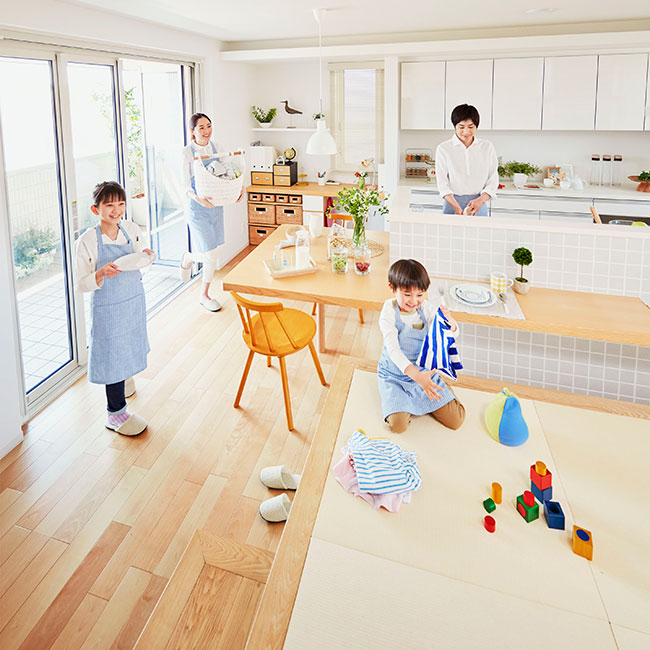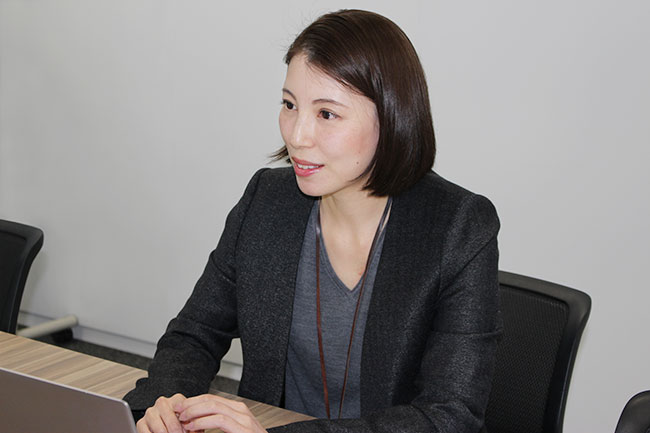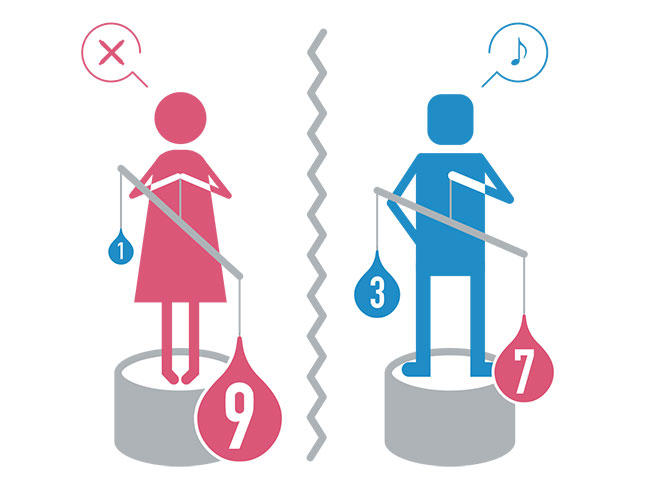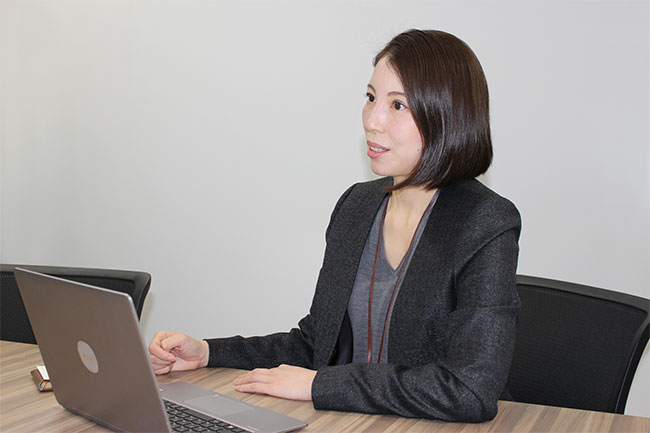
The word “Housework” is typically associated with chores like cooking, laundry, and cleaning. In reality, however, housework includes many other unspecified tasks like putting away clothes that are lying around, throwing away unneeded flyers, and straightening up shoes that are scattered in the entranceway. Moreover, it is likely that a single family member is responsible for most of these “Nameless Chores”.
Aki Mitoma, a member of Dentsu’s Business Transformation Division, closely examined these unavoidable household tasks, dubbed “Nameless Chores,” while working on a project for Daiwa House Industry Co., Ltd., a leading homebuilder in Japan. Responsible for communications, she incorporated this concept in a campaign to promote the client’s Kaji Share House brand of homes (kaji means “housework” in Japanese), which are cleverly designed to facilitate the sharing of household duties among all family members.
The campaign has been highly acclaimed and won several awards, including a Golden World Award for Excellence in the Communication Research category from the International Public Relations Association. In this interview, we asked Aki Mitoma to talk about her involvement in the project and the production methods she applied while looking back on the campaign.
More than just marketing, the goal was to help foster a household culture
“Nameless Chores” tend to end up being done by a single person in a household, and the Kaji Share House concept arose as a solution to that problem. Where did this idea originate from?
The idea first came from female employees (working under temporary contracts at the time) at a Daiwa House branch office in the city of Toyama. The company had an internal system for soliciting home design suggestions from employees, and the female employees first submitted their proposal after discussing it together.
Family members are responsible for chores typically associated with housework, such as cooking, doing laundry, and cleaning, but the concept of this project is rooted in the fact that housework involves more than just those chores. We also need to do things like straightening up the shoes in the entranceway, and turning inside-out socks the right side out before putting them in the washing machine. There are many “Nameless Chores” like these, but it is difficult to make other family members realize how much time they take. Moreover, the wife is generally assumed to be responsible for these chores. Therefore, the employees considered ways to reduce the burden of these tasks in the design of the homes.
What role did you play in this project?

I was involved in the communications side of the promotional campaign. The female employees’ idea of a home designed to facilitate shared housework took some time to develop until the Kaji Share House brand was finally created. When Daiwa House launched the brand nationwide in 2017, the company consulted with us on ways to market and promote it.
In most cases, communications and PRs work are normally intended to promote advantages of a product and boost its name recognition. In this project, however, the goal was more about raising awareness of “Nameless Chores” in household, encouraging better housework habits, and fostering a new housework culture.
The first thing I did with the client was to try and understand exactly what it was aiming for. More than just marketing the homes, the people at Daiwa House talked about changing housework habits and creating a new housework culture through the Kaji Share House concept. They expressed a desire to change the ways that individual families do household chores, especially since the proportion of dual-income households is growing. Therefore, instead of focusing on the product, we proposed ideas and plans for framing the issue of household chores and promoting a new culture of housework.
Confronting a social issue while also contributing to problem-solving at the company offering the product
How did you go about presenting those ideas in practical terms?
First of all, I talked with the female employees of the branch office in Toyama in order to understand the core of our assignment. Based on those discussions, we devised some strategies for raising awareness about nameless chores. One visual technique we used was a housework annual income simulator, which calculates the monetary value of unnamed household chores and presents housework in terms of annual income. In addition, with a view to raising public awareness about this issue, we carried out a housework-related opinion survey of dual-income spouses between the ages of 20 and 49 in 2017.
The results of that survey were very clear. We asked dual-income married couples to estimate the ratio of housework duties handled by each spouse. Among female participants, the top response was that 90% of housework was handled by the wife and around 10% by the husband. Among male participants, however, the most common response was 70% by the wife and 30% by the husband. In other words, the husbands thought that they were doing more housework than their wives believed. We focused on that perception gap, as it seemed to indicate how nameless household chores are taken for granted.

On the other hand, because housework is a routine task, changing household habits must be an ongoing goal. Therefore, we helped Daiwa House publish a website that ranks every prefecture in Japan according to the level at which housework is shared, and organized a series of events related to housework sharing. I hope these initiatives create opportunities for people to change their actions after becoming more aware of the issue.
These initiatives were aimed at dealing with a social issue, but for me, personally, in addition to the social aspect, I hope the project contributes to problem-solving at Daiwa House, and for the workers themselves. The conscious efforts to design homes that facilitate shared housework and to raise awareness of nameless chores were highly beneficial for both the company and its employees.
What specifically was accomplished?
As I said before, the idea of designing housework-sharing homes originally came from female contract employees at Daiwa House’s Toyama branch office. That happened in the context of a few important factors: Diversity Promotion Section Human Resources Department had set up a section to promote diversity, and the system for soliciting ideas from all employees was put in place. In that light, the Kaji Share House project is an exemplary and symbolic outcome of those in-house initiatives. By precisely identifying that context from the outset, I presented an image of the company and the goals it should pursue to the employees.
In addition, we recently conducted an opinion survey of the female employees at Daiwa House, and over 1,000 of those employees responded. The survey results indicated that there are challenges for the company with respect to promoting diversity and the success of women in the workplace. In other words, the project not only tried to raise public awareness of housework and correct the imbalance of household chores in dual-income families, but also played a part in the company’s own policies and approach to human resources.
Starting from my own standpoint, I try to broaden my perspective to include businesses and the public at large
What is your reason for considering both the public and businesses in your work?
As a producer, it is really important to always look at the bigger picture. When setting some kind of goal, people often lose track of it. For that reason, I make a point of understanding the perspectives of companies in the private sector and the public at large, because taking several perspectives puts me in a position to see the bigger picture.
In this project, in particular, the goals were to change how people do household chores and foster a new housework culture. Those goals are practically impossible to achieve in just one project, so a system that continues for a long time is required. Nevertheless, if we could make the project really significant for the company itself, it would be easy to keep it going in the future. That is the reason why I considered both angles. In that sense, I was happy that I could consider the significance of the project for the company together with members of the client’s team as we carried it out.
Which specific methods in this project were important?
As I mentioned before, our intention was not to showcase all of the advantages of the Kaji Share House brand of homes. Instead, we were focusing on its specific advantages for dual-income families with respect to doing “Nameless Chores”.
Besides that, I conceived of specific tips and methods for sharing housework duties for the purpose of creating promotional content. When discussing those things with the client’s team, however, they explained that the situation and goals of each household differ with respect to housework sharing and “Nameless Chores”. So, in that sense, explaining specific instructions for sharing housework deviated somewhat from the client’s intention. It was good that we had opportunities to discuss and consider such issues together.
Ideally, I try to adapt myself so that I can fully understand the essence of a project and its underlying issues. Then I try to take a broader public perspective while considering how to resolve those issues. At the same time, I look to broaden my view to include the benefits for the company promoting the product. By taking these steps, I can better grasp the essence of the project while looking at the bigger picture.
I think that I was able to do those things in this project. I also come from a dual-income family, and based on my own experience, I wanted to broaden my perspective to include the company and the public as a whole.
Nonetheless, besides communications, Dentsu’s area of specialty, I believe other methods are necessary for resolving issues. Therefore, while starting from communications, I intend to explore other kinds of solutions in the future. For example, I hope to find solutions for consumer issues and social problems together with our clients as a partner capable of driving innovations in product development, new business development, and so on. While working closely with our clients, I would like to offer the best solutions that capture the essence of what they need.


Aki Mitoma
Business Transformation Producer
Business Transformation Division

